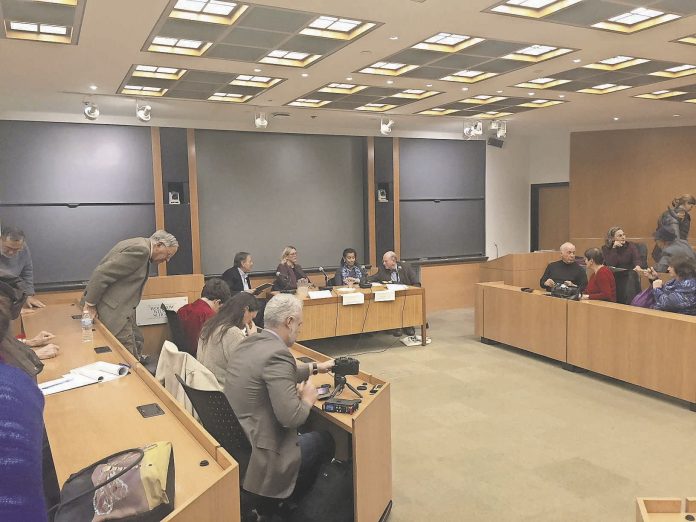
A panel of three experts in the field of global security gathered to speak Nov. 13 at Princeton University in conjunction with an art exhibit titled “Shadows and Ashes: The Peril of Nuclear Weapons
By Carson Welch, Correspondent
On Monday, a panel of three experts in the field of global security gathered to speak at Princeton University in conjunction with an art exhibit titled “Shadows and Ashes: The Peril of Nuclear Weapons,” which includes multimedia works that navigate the topic of nuclear violence.
“We are in a state of brinksmanship around the world right now,” said Bruce Blair, a former launch control officer for a U.S. nuclear missile silo and a recipient of the MacArthur “Genius” Grant for his work on curbing the risks of nuclear weapons. “You can see it in the relationship between Donald Trump and Kim Jung Un. The escalation here is sharp, and is moving in the wrong direction.”
Although nuclear tensions seem perpetual, Blair said, there are other, more logistical risks that come bound with nuclear arsenals.
“Accidental detonation, unauthorized launches, mistaken launches on false warning, nuclear brinksmanship that spins out of control,” said Blair. “These risks are essentially unmanageable, short of the elimination of nuclear weapons.”
Blair, who is a scholar of nuclear risk in Princeton’s Program on Science and Global Security, has seen the precarious process of nuclear escalation. During the Yom Kippur War of 1973, when the U.S. was looking to deter Soviet leader Leonid Brezhnev from supporting the Egyptian army, Blair and another officer, who would have been responsible for launching more than 50 warheads toward the U.S.S.R. and China, were told to brace for an eminent nuclear attack.
“They didn’t call us ‘Minute Men’ for nothing,” Blair said. “Roughly 800 nuclear warheads could be fired instantaneously, right now, without any prior awareness or preparation of forces. It would destroy the world.”
But “the horizon of nuclear risk,” as Blair called it, reaches even to the majority of countries that have no nuclear arsenal themselves, or in the case of Costa Rican Ambassador Elayne Whyte Gómez, who organized the United Nations Treaty on the Prohibition of Nuclear Weapons in 2017, no military at all. Ambassador Gómez said that the unarmed global community, too, must exercise its agency in opposing nuclear proliferation.
“Something is going to happen,” said Gómez, “either by natural evolution, or by limited or complete war, or because we come to our senses and actually engage at the international arena to solve something about this problem.”
Gómez and Blair were joined by Sharon Weiner, an associate professor at American University, who had been in charge of the nuclear budget under President Barack Obama. Weiner’s time working at the White House marked the beginning of the “modernization” program, Obama’s compromise with a Republican-held congress that continued arms reduction while improving the technologies of those remaining missiles, launchers, nuclear facilities and their security.
“The argument was that if you reduce the number of nuclear weapons, you would need to modernize the smaller number that you have,” said Weiner. “But the current projected budget of the next 30 years for the U.S. arsenal is 1.2 trillion dollars… and the cost of this modernization program goes up frequently.”
Outside the crowded room where the panel spoke, in the basement of Robertson Hall, the art exhibit “Shadows and Ashes: The Peril of Nuclear Weapons” is on display, focusing on the Japanese victims of U.S. nuclear violence. It features the portraits of Hiroshima survivors by photographer Gary Schoichet, which apprehend the effects of nuclear war, as well as Schoichet’s photographs from the 1982 Anti-Nuclear Rally in New York City.
In 1947, a number of children who survived the bombing of Hiroshima made a series of crayon drawings, which have been collected and were provided by All Souls Church in Washington D.C. The exhibit also includes sculpted masks, otherworldly and haunting, by artist Marion Held, in commemoration of the Japanese nuclear catastrophe.
“Shadows and Ashes,” which includes informative graphic and video displays provided by the Program on Science and Global Security at Princeton’s Woodrow Wilson School of Public and International Affairs, will be on display until Dec. 8, 2017.

